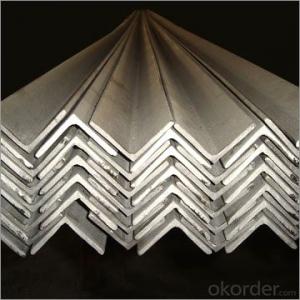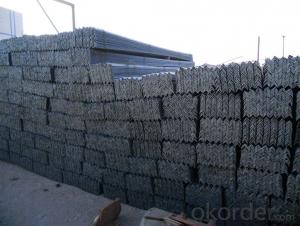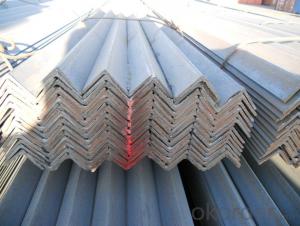Angle steel GB Q235B 20-250MM high quality hot rolled
- Loading Port:
- Tianjin
- Payment Terms:
- TT OR LC
- Min Order Qty:
- 25 m.t.
- Supply Capability:
- 20000 m.t./month
OKorder Service Pledge
OKorder Financial Service
You Might Also Like
Angle Steel Details:
| Minimum Order Quantity: | 25mtons | Unit: | m.t. | Loading Port: | China Main Port |
| Supply Ability: | 80000-100000MTS/YEAR | Payment Terms: | TT or LC |
Product Description:
Specifications of Angle Steel
1. Invoicing on theoretical weight or actual weight as customer request
2. Length: 6m, 9m, 12m as following table
3. Sizes

Sizes: 25mm-250mm | ||
a*t | ||
25*2.5-4.0 | 70*6.0-9.0 | 130*9.0-15 |
30*2.5-6.6 | 75*6.0-9.0 | 140*10-14 |
36*3.0-5.0 | 80*5.0-10 | 150*10-20 |
38*2.3-6.0 | 90*7.0-10 | 160*10-16 |
40*3.0-5.0 | 100*6.0-12 | 175*12-15 |
45*4.0-6.0 | 110*8.0-10 | 180*12-18 |
50*4.0-6.0 | 120*6.0-15 | 200*14-25 |
60*4.0-8.0 | 125*8.0-14 | 250*25 |
5. Payment terms:
1).100% irrevocable L/C at sight.
2).30% T/T prepaid and the balance against the copy of B/L.
3).30% T/T prepaid and the balance against L/C
6.Material details:
Alloy No | Grade | Element (%) | |||||
C | Mn | S | P | Si | |||
|
|
|
|
|
|
| |
Q235 | B | 0.12—0.20 | 0.3—0.7 | ≤0.045 | ≤0.045 | ≤0.3 | |
|
|
|
|
|
|
| |
Alloy No | Grade | Yielding strength point( Mpa) | |||||
Thickness (mm) | |||||||
≤16 | >16--40 | >40--60 | >60--100 | ||||
≥ | |||||||
|
|
|
|
|
| ||
Q235 | B | 235 | 225 | 215 | 205 | ||
Alloy No | Grade | Tensile strength (Mpa) | Elongation after fracture (%) | ||||
Thickness (mm) | |||||||
| ≤16 | >16--40 | >40--60 | >60--100 | |||
≥ | |||||||
|
|
|
|
|
|
| |
Q235 | B | 375--500 | 26 | 25 | 24 | 23 | |
Usage & Applications of Angle Steel
According to the needs of different structures, Angle can compose to different force support component, and also can be the connections between components. It is widely used in various building structures and engineering structures such as roof beams, bridges, transmission towers, hoisting machinery and transport machinery, ships, industrial furnaces, reaction tower, container frame and warehouse etc.
Packaging & Delivery of Angle Steel
1. Packing: it is nude packed in bundles by steel wire rod
2. Bundle weight: not more than 3.5MT for bulk vessel; less than 3 MT for container load
3. Marks:
Color marking: There will be color marking on both end of the bundle for the cargo delivered by bulk vessel. That makes it easily to distinguish at the destination port.
Tag mark: there will be tag mark tied up on the bundles. The information usually including supplier logo and name, product name, made in China, shipping marks and other information request by the customer.
If loading by container the marking is not needed, but we will prepare it as customer request.
Production flow of Angle Steel
Material prepare (billet) —heat up—rough rolling—precision rolling—cooling—packing—storage and transportation
- Q:How do you calculate the deflection of a steel angle under load?
- To calculate the deflection of a steel angle under load, you can use the principles of structural engineering and the concept of beam deflection. The deflection of a beam is the degree to which it bends or sags under an applied load. Firstly, you need to determine the properties of the steel angle, such as its cross-sectional area, moment of inertia, and modulus of elasticity. These properties can be obtained from the manufacturer's specifications or through testing. Next, you should determine the type of loading the steel angle will be subjected to, such as a uniformly distributed load or a concentrated load. The magnitude and distribution of the load will affect the deflection. Once you have the necessary information, you can use various equations and formulas to calculate the deflection. One commonly used equation is the Euler-Bernoulli beam equation, which relates the deflection of a beam to the applied load, its length, and the properties of the material. The equation for calculating the deflection of a simply supported beam, such as a steel angle, under a uniformly distributed load is: δ = (5 * w * L^4) / (384 * E * I) Where: δ is the deflection w is the uniform load per unit length L is the length of the beam E is the modulus of elasticity of the steel angle I is the moment of inertia of the steel angle about its neutral axis For a concentrated load, the equation would be slightly different. Additionally, if the steel angle is not simply supported but has different boundary conditions, such as being fixed at one end, the equations will vary accordingly. It's important to note that these equations provide an estimate of the deflection, assuming the steel angle behaves linearly and elastically. In reality, there might be other factors affecting the deflection, such as material imperfections or non-linear behavior under high loads. Therefore, it is always recommended to consult a structural engineer or utilize specialized software for a more accurate and comprehensive deflection calculation.
- Q:Can steel angles be used for supports in bridges?
- Yes, steel angles can be used for supports in bridges. Steel angles are commonly used in bridge construction as they provide strength and stability. They are used as vertical supports, known as piers or columns, and as horizontal supports, known as beams or girders. Steel angles offer several advantages for bridge construction, including their high strength-to-weight ratio and their ability to withstand heavy loads and vibrations. They are also versatile and can be easily fabricated and connected, allowing for efficient and cost-effective bridge construction. Overall, steel angles are a popular choice for bridge supports due to their durability, reliability, and efficiency in supporting the weight and load of a bridge structure.
- Q:Can steel angles be used as handrails or guardrails?
- Handrails or guardrails can indeed be made using steel angles. The strength and durability of steel angles make them a popular choice in construction and industrial settings. When designed, fabricated, and installed correctly, steel angles offer a dependable support system for handrails and guardrails. By welding or bolting them to other structural components, a secure and safe railing system can be created. Moreover, steel angles are easily customizable to match specific design and aesthetic preferences. However, it is crucial to verify that the steel angles used adhere to the necessary safety standards and building codes, ensuring the safety and well-being of those utilizing the handrails or guardrails.
- Q:Are there any industry standards or certifications for steel angles?
- Steel angles have industry standards and certifications. The main standard for steel angles is the ASTM standard, specifically the ASTM A36 specification. This specification outlines the necessary chemical composition, mechanical properties, and dimensional tolerances for structural steel angles. Aside from ASTM, other organizations like AISC and SJI also provide guidelines and standards for steel angles used in construction and structural engineering. These standards guarantee that steel angles meet specific requirements in terms of quality, strength, and performance. Moreover, certifications like ISO 9001:2015 and ISO 14001:2015 are widely recognized in the steel industry. These certifications indicate that a manufacturer has implemented a quality management system and complies with environmental management standards. Adhering to these industry standards and certifications is crucial for manufacturers, suppliers, and construction professionals. It ensures the dependability and safety of steel angles in various applications.
- Q:Are there any environmental concerns related to the production or disposal of steel angles?
- Yes, there are environmental concerns related to the production and disposal of steel angles. The production of steel angles involves energy-intensive processes that contribute to greenhouse gas emissions and air pollution. Moreover, the extraction of raw materials for steel production can lead to habitat destruction and ecosystem disruption. Additionally, if steel angles are not properly disposed of, they can contribute to waste accumulation and potential environmental contamination.
- Q:Can steel angles be used for bracing purposes?
- Yes, steel angles can be used for bracing purposes. Steel angles are commonly used as structural components in construction due to their strength and durability. They are often used to provide additional support and stability to various structures, including buildings, bridges, and industrial equipment. Steel angles can be easily bolted or welded to the main framework of a structure, providing additional rigidity and resisting forces such as compression, tension, and lateral loads. Their versatile shape allows for a wide range of bracing applications, making them a popular choice for bracing purposes in construction and engineering projects.
- Q:What are the common methods of surface preparation for steel angles?
- Steel angles can be prepared for surface treatment through various methods, including grinding, sandblasting, and chemical cleaning. Grinding is a mechanical technique that involves using an abrasive wheel or disc to smooth and level the surface of the steel angle. This method effectively eliminates rust, scale, and other imperfections. It is commonly used for small-scale projects or when achieving a smooth surface finish is not crucial. Sandblasting, also referred to as abrasive blasting, entails propelling small particles onto the surface of the steel angle at high speeds. This method is highly efficient in removing mill scale, rust, paint, and other contaminants. Sandblasting creates a textured surface that enhances the adhesion of coatings or paints. It is often employed in large-scale industrial projects that require a high-quality surface finish. Chemical cleaning involves the use of chemical solutions to eliminate contaminants from the surface of the steel angle. This method effectively removes rust, oil, grease, and other organic materials. Chemical cleaning can be carried out using various techniques, such as immersion or brush application. It is typically employed when sandblasting or grinding is not feasible or practical. Additionally, power tool cleaning, flame cleaning, or a combination of methods may be used for surface preparation, depending on the specific project requirements. It is crucial to select the appropriate method based on the condition of the steel angle, the desired surface finish, and the intended application of the steel angle.
- Q:What is the maximum length for a steel angle?
- The maximum length of a steel angle can differ based on the angle's specific type and size, as well as the steel supplier's manufacturing capabilities. Typically, steel angles are offered in standard lengths spanning from 20 to 40 feet. However, longer lengths could be attainable via custom orders or specialized production methods. To ascertain the readily available or obtainable maximum length for a particular steel angle, it is advisable to seek guidance from a steel supplier or manufacturer.
- Q:What are the tolerance specifications for steel angles?
- The tolerance specifications for steel angles can differ based on various organizations and industries' specific standards and requirements. However, in general, the tolerance specifications for steel angles typically encompass measurements for dimensions like leg length, thickness, and straightness. Leg length tolerance ensures that the angle's legs are within an acceptable range of the desired measurement by allowing a certain deviation from the specified leg length. For instance, a tolerance specification of ±1/8 inch permits the leg length to deviate by up to 1/8 inch in either direction from the specified dimension. Thickness tolerance denotes the allowable deviation in the thickness of the steel angle. This specification guarantees consistency and adherence to an acceptable range of thickness. It is usually expressed as a percentage or an absolute value. For example, a tolerance specification of ±10% permits the thickness to deviate by up to 10% above or below the specified dimension. Straightness tolerance ensures that the steel angle is not bent or twisted and meets the required straightness criteria. It is commonly measured by the maximum allowable deviation from a straight line. This tolerance specification guarantees ease of fitting and alignment during construction or manufacturing processes. It is important to note that the specific tolerance specifications for steel angles may vary depending on the intended application, industry standards, and regulatory requirements. Therefore, it is recommended to consult the manufacturer, industry associations, or governing bodies for accurate and up-to-date information on the tolerance specifications for steel angles by referring to the relevant standards, codes, or specifications.
- Q:How do you calculate the moment of resistance for a steel angle?
- The moment of resistance for a steel angle can be calculated by multiplying the yield strength of the material by the plastic section modulus of the angle. The plastic section modulus is determined by considering the extreme fiber locations and their corresponding distances from the centroid of the shape.
1. Manufacturer Overview |
|
|---|---|
| Location | |
| Year Established | |
| Annual Output Value | |
| Main Markets | |
| Company Certifications | |
2. Manufacturer Certificates |
|
|---|---|
| a) Certification Name | |
| Range | |
| Reference | |
| Validity Period | |
3. Manufacturer Capability |
|
|---|---|
| a)Trade Capacity | |
| Nearest Port | |
| Export Percentage | |
| No.of Employees in Trade Department | |
| Language Spoken: | |
| b)Factory Information | |
| Factory Size: | |
| No. of Production Lines | |
| Contract Manufacturing | |
| Product Price Range | |
Send your message to us
Angle steel GB Q235B 20-250MM high quality hot rolled
- Loading Port:
- Tianjin
- Payment Terms:
- TT OR LC
- Min Order Qty:
- 25 m.t.
- Supply Capability:
- 20000 m.t./month
OKorder Service Pledge
OKorder Financial Service
Similar products
New products
Hot products
Hot Searches
Related keywords




























